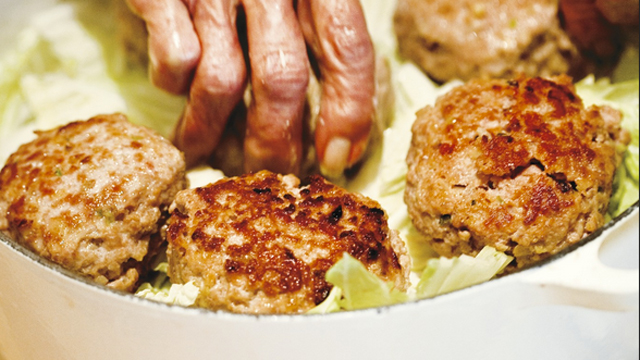- 1 large head (about 11/2 pounds) napa cabbage
- 4 ounces bean-thread (cellophane) noodles
- 1 pound lean ground pork
- 1/4 cup (about 4 ounces) drained and finely minced canned water chestnuts
- 1 tablespoon minced green onions, white part only
- 1 tablespoon peeled, minced unpeeled fresh ginger
- 3 teaspoons kosher salt
- 3 tablespoons premium soy sauce
- 1 tablespoon Shaoxing wine
- 1/2 teaspoon freshly ground white pepper
- Peanut or vegetable oil, for frying
- 1 1/2 cups Delicious Chicken Broth
- 1/2 cup water
Ingredients
- Trim off the root end of the cabbage head and reserve. Quarter the leaves lengthwise and then cut them again crosswise into thirds. Set aside.
- To prepare the noodles: pour hot water over the bean-thread noodles in a bowl, and let them soak until they are soft, about 15 minutes. Keep the noodles in the water until ready to use, as they tend to dry out quickly.
- To form the meatballs: combine the pork, water chestnuts, green onions, ginger, 2 teaspoons of the salt, 1 tablespoon of the soy sauce, wine, and white pepper in a bowl. Using your hands, gently mix all of the ingredients together until well combined. Don’t overmix, or the pork will become gummy. Lightly oil a rimmed baking sheet. Using a 1/2-cup measure, loosely form the pork into 4-ounce balls and place them on the prepared baking sheet. Set aside.
- Line a plate with paper towels and have it ready near the cooktop. Heat a large nonstick skillet over high heat until a bead of water dances on the surface and then evaporates. Cover the bottom of the skillet with a thin film of the oil and swirl to coat. Arrange the meatballs in a single layer in the bottom of the pan, but do not overcrowd them (depending on the size of your pan, you might need to cook the meatballs in several batches). Decrease the heat to medium and cook the meatballs, turning with tongs to cook evenly, until all sides are well browned, about 6 minutes. Transfer the meatballs to the prepared plate. Repeat this process for as many batches as needed.
- Put the reserved root ends of the cabbage in the bottom of a large saucepan. Gently place the meatballs on top, and pour over the chicken broth and the 1/2 cup of water. Bring the pot to a boil over high heat, decrease the heat to medium-low, and simmer the mixture, uncovered, until it has cooked down a bit, about 5 minutes. Add the cut-up cabbage leaves and the remaining 1 teaspoon of salt. Cover the pot with a tight-fitting lid and continue to simmer until the meatballs are cooked through and the cabbage is tender, about 10 minutes more.
- Drain the noodles, add to the saucepan with the remaining 2 tablespoons of soy sauce, and stir to combine well. Remove the pan from the heat.
- To serve, arrange the meatballs on top of the cabbage and noodles on a platter. Serve immediately.



Search or Browse Recipes
Course
Cuisine
Occasion
Theme